turn signal BMW ACTIVEHYBRID 5 2012 Owners Manual
[x] Cancel search | Manufacturer: BMW, Model Year: 2012, Model line: ACTIVEHYBRID 5, Model: BMW ACTIVEHYBRID 5 2012Pages: 319, PDF Size: 12.54 MB
Page 13 of 319
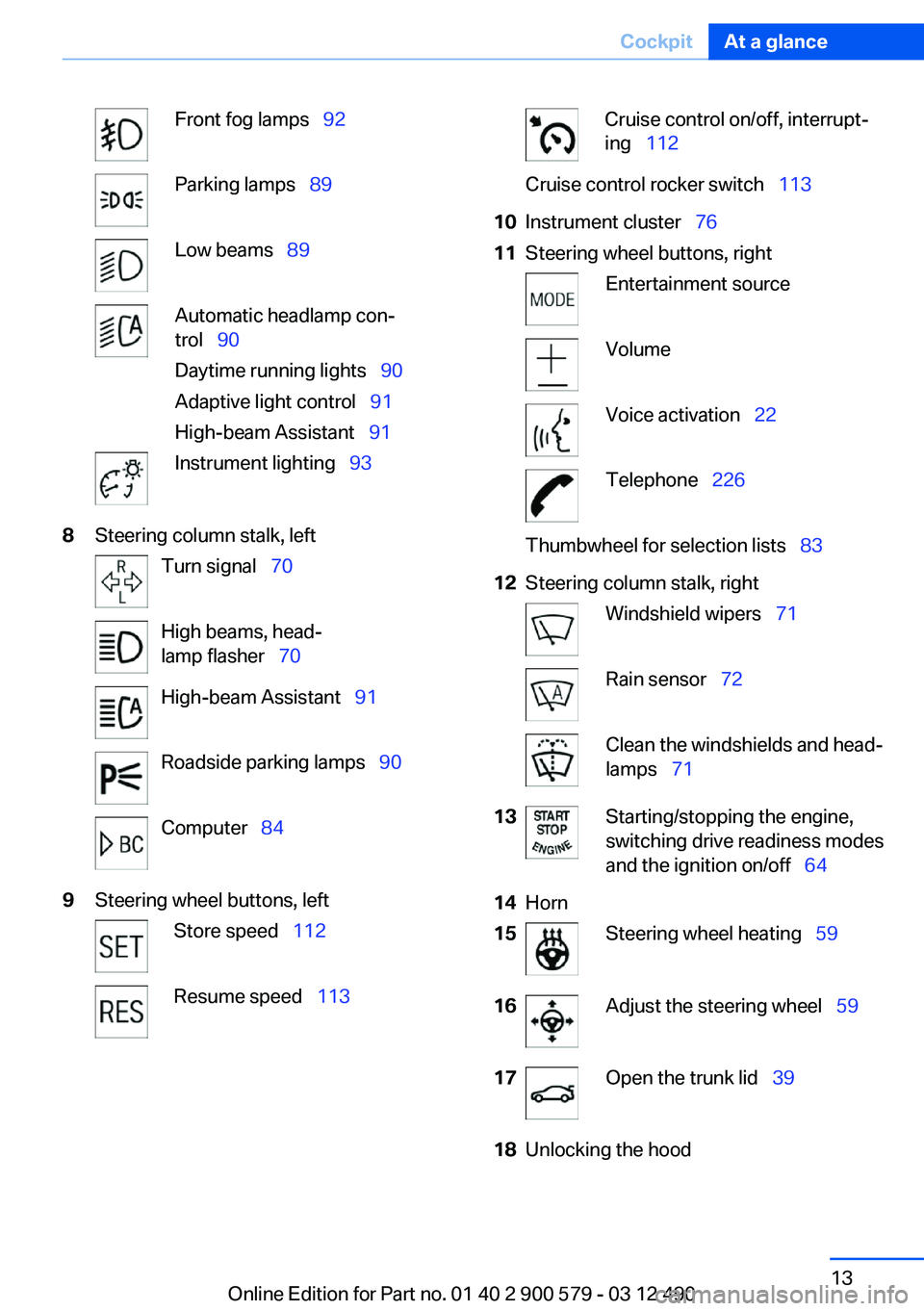
Front fog lamps‚Äā‚ÄÖ92Parking lamps‚Äā‚ÄÖ89Low beams‚Äā‚ÄÖ89Automatic headlamp con‚Äź
trol‚Äā‚ÄÖ 90
Daytime running lights‚Äā‚ÄÖ 90
Adaptive light control‚Äā‚ÄÖ 91
High-beam Assistant‚Äā‚ÄÖ 91Instrument lighting‚Äā‚ÄÖ938Steering column stalk, leftTurn signal‚Äā‚ÄÖ70High beams, head‚Äź
lamp flasher‚Äā‚ÄÖ 70High-beam Assistant‚Äā‚ÄÖ 91Roadside parking lamps‚Äā‚ÄÖ 90Computer‚Äā‚ÄÖ849Steering wheel buttons, leftStore speed‚Äā‚ÄÖ 112Resume speed‚Äā‚ÄÖ 113Cruise control on/off, interrupt‚Äź
ing‚Äā‚ÄÖ 112Cruise control rocker switch‚Äā‚ÄÖ 11310Instrument cluster‚Äā‚ÄÖ7611Steering wheel buttons, rightEntertainment sourceVolumeVoice activation‚Äā‚ÄÖ22Telephone‚Äā‚ÄÖ226Thumbwheel for selection lists‚Äā‚ÄÖ 8312Steering column stalk, rightWindshield wipers‚Äā‚ÄÖ71Rain sensor‚Äā‚ÄÖ72Clean the windshields and head‚Äź
lamps‚Äā‚ÄÖ 7113Starting/stopping the engine,
switching drive readiness modes
and the ignition on/off‚Äā‚ÄÖ 6414Horn15Steering wheel heating‚Äā‚ÄÖ 5916Adjust the steering wheel‚Äā‚ÄÖ 5917Open the trunk lid‚Äā‚ÄÖ3918Unlocking the hoodSeite 13CockpitAt a glance13
Online Edition for Part no. 01 40 2 900 579 - 03 12 490
Page 35 of 319

4.Open "Guest".5.Create the settings.
Note: the guest profile cannot be renamed.
Display profile list during start
The profile list can be displayed during each
start for selecting the desired profile.
1."Settings"2."Profiles"3."Options" Open.4."Display user list at startup"
Personal Profile settings
The following functions and settings can be
stored in a profile.
More information on the settings can be found
under:
‚Ė∑Exterior mirror position.‚Ė∑CD/Multimedia: audio source listened to
last.‚Ė∑Driving Experience Switch: sport program.‚Ė∑Driver's seat position: automatic retrieval af‚Äź
ter unlocking.‚Ė∑Programmable memory buttons: assign‚Äź
ment.‚Ė∑Head-up Display: selection, brightness, po‚Äź
sition and rotation of the display.‚Ė∑Headlamp courtesy delay feature: time set‚Äź
ting.‚Ė∑Tone: tone settings.‚Ė∑Automatic climate control: settings.‚Ė∑Steering wheel position.‚Ė∑Navigation: map views, route criteria, voice
output on/off.‚Ė∑Night Vision with pedestrian detection: se‚Äź
lection of functions and type of display.‚Ė∑Park Distance Control PDC: adjusting the
signal tone volume.‚Ė∑Radio: stored stations, station listened to
last, special settings.‚Ė∑Backup camera: selection of functions and
type of display.‚Ė∑Side View: selection of the display type.‚Ė∑Language on the Control Display.‚Ė∑Lane departure warning: last setting, on/off.‚Ė∑Active Blind Spot Detection: last setting, on/
off.‚Ė∑Daytime running lights: current setting.‚Ė∑Triple turn signal activation.‚Ė∑Locking the vehicle: after a brief period or
after starting to drive.
Central locking system
The concept
The central locking system becomes active
when the driver's door is closed.
The system simultaneously engages and re‚Äź
leases the locks on the following:
‚Ė∑Doors.‚Ė∑Trunk lid.‚Ė∑Fuel filler flap.
Operating from the outside
‚Ė∑Via the remote control.‚Ė∑Via the driver's door lock.‚Ė∑Via the door handles.‚Ė∑Via the button in the trunk lid.
The following takes place simultaneously when
locking/unlocking the vehicle via the remote
control:
‚Ė∑Depending on how the vehicle is equipped,
the theft protection is activated/deactivated.
Theft protection prevents the doors from
being unlocked using the lock buttons or the
door opener.‚Ė∑The welcome lamps, interior lamps and
courtesy lamps are switched on and off.‚Ė∑The alarm system, refer to page 44, is
armed or disarmed.Seite 35Opening and closingControls35
Online Edition for Part no. 01 40 2 900 579 - 03 12 490
Page 70 of 319

The indicator lamp lights up.
Automatic Hold is activated.
Deactivating Press the button again.
The LED and the letters AUTO H go
out.
Automatic Hold is deactivated.
If the vehicle is being held by Automatic Hold,
press on the brake pedal to deactivate it.
When the parking brake is set manually, Auto‚Äź
matic Hold is deactivated automatically.
Driving
Automatic Hold is activated: the vehicle is auto‚Äź
matically secured against rolling when it stops.
The indicator lamp lights up green.
Step on the accelerator pedal to drive
off.
The brake is released automatically.
The indicator lamp goes out.
Lower lamp: indicator lamp in Canadian models
Before driving into a car wash
Deactivate Automatic Hold; otherwise, the
parking brake will be set when the vehicle is sta‚Äź
tionary and the vehicle will no longer be able to
roll.‚óÄ
Parking
The parking brake is automatically set if the en‚Äź
gine is switched off while the vehicle is being
held by Automatic Hold.
The indicator lamp changes from green
to red.
The parking brake is not set if the engine
is switched off while the vehicle is coast‚Äź
ing to a halt. Automatic Hold is deacti‚Äź
vated.
Lower lamp: indicator lamp in Canadian modelsTake the remote control with you
Take the remote control with you when
leaving the vehicle so that children, for example,
cannot release the parking brake.‚óÄ
Malfunction
In the event of a failure or malfunction of the
parking brake, secure the vehicle against rolling
using a wheel chock, for example, when leaving
it.
Turn signal, high beams,
headlamp flasher
Turn signal
Using turn signals
Press the lever beyond the resistance point.
To switch off manually, press the lever to the re‚Äź
sistance point.
Unusually rapid flashing of the indicator lamp in‚Äź
dicates that a turn signal bulb has failed.
Triple turn signal activation
Press the lever to the resistance point.
The turn signal flashes three times.
The function can be activated or deactivated:
1."Settings"2."Lighting"Seite 70ControlsDriving70
Online Edition for Part no. 01 40 2 900 579 - 03 12 490
Page 71 of 319
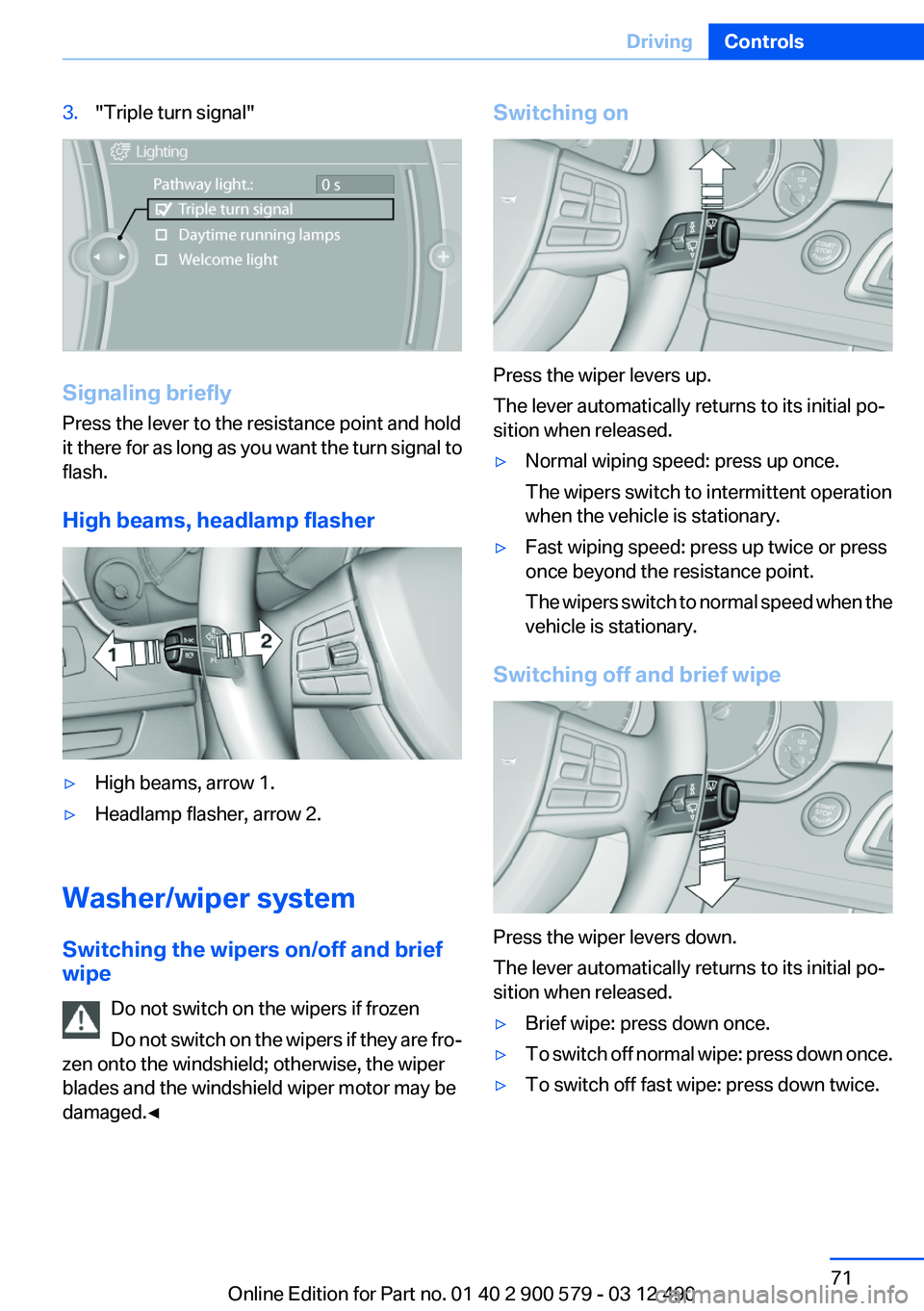
3."Triple turn signal"
Signaling briefly
Press the lever to the resistance point and hold
it there for as long as you want the turn signal to
flash.
High beams, headlamp flasher
‚Ė∑High beams, arrow 1.‚Ė∑Headlamp flasher, arrow 2.
Washer/wiper system
Switching the wipers on/off and brief
wipe
Do not switch on the wipers if frozen
Do not switch on the wipers if they are fro‚Äź
zen onto the windshield; otherwise, the wiper
blades and the windshield wiper motor may be
damaged.‚óÄ
Switching on
Press the wiper levers up.
The lever automatically returns to its initial po‚Äź
sition when released.
‚Ė∑Normal wiping speed: press up once.
The wipers switch to intermittent operation
when the vehicle is stationary.‚Ė∑Fast wiping speed: press up twice or press
once beyond the resistance point.
The wipers switch to normal speed when the
vehicle is stationary.
Switching off and brief wipe
Press the wiper levers down.
The lever automatically returns to its initial po‚Äź
sition when released.
‚Ė∑Brief wipe: press down once.‚Ė∑To switch off normal wipe: press down once.‚Ė∑To switch off fast wipe: press down twice.Seite 71DrivingControls71
Online Edition for Part no. 01 40 2 900 579 - 03 12 490
Page 78 of 319
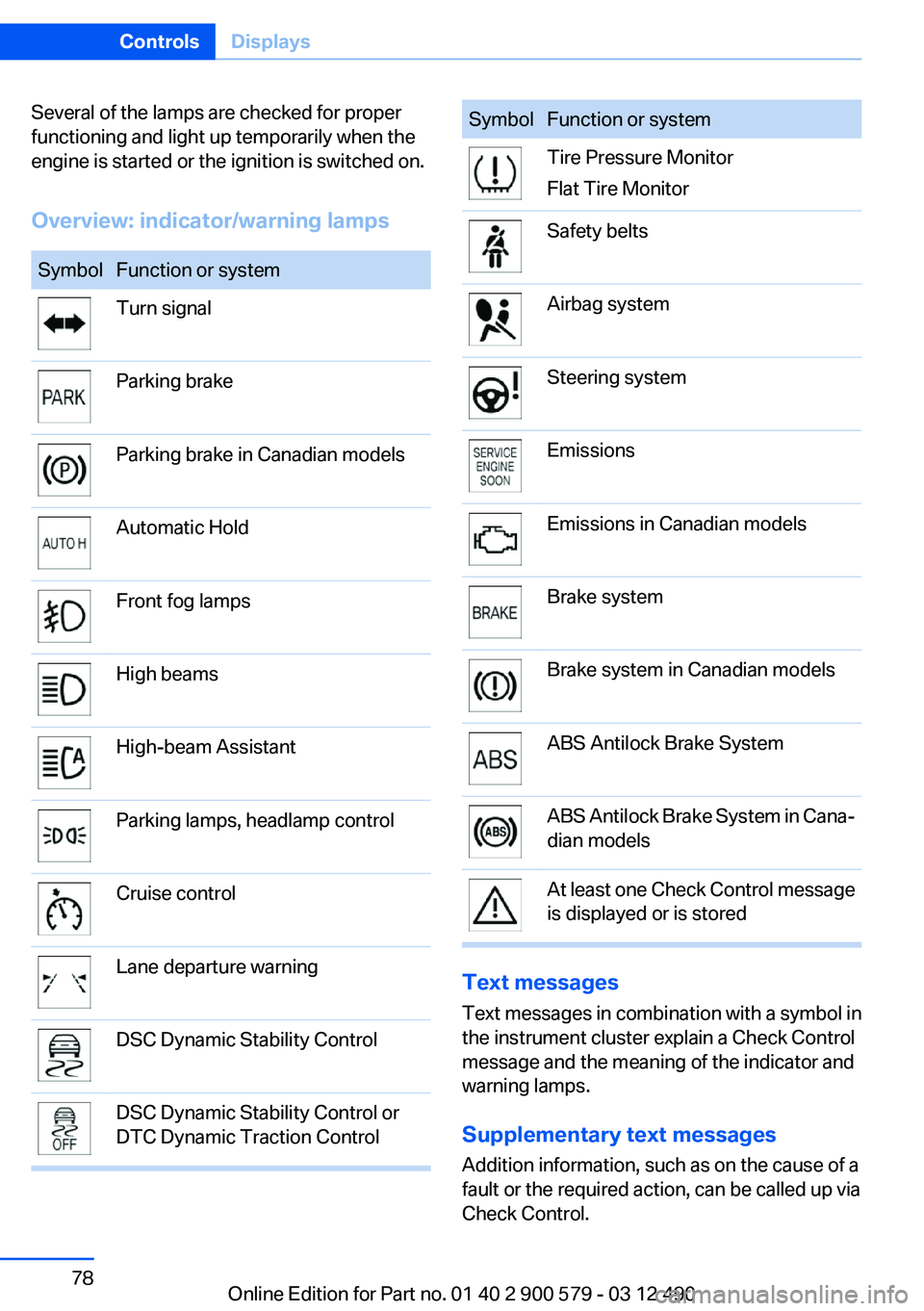
Several of the lamps are checked for proper
functioning and light up temporarily when the
engine is started or the ignition is switched on.
Overview: indicator/warning lampsSymbolFunction or systemTurn signalParking brakeParking brake in Canadian modelsAutomatic HoldFront fog lampsHigh beamsHigh-beam AssistantParking lamps, headlamp controlCruise controlLane departure warningDSC Dynamic Stability ControlDSC Dynamic Stability Control or
DTC Dynamic Traction ControlSymbolFunction or systemTire Pressure Monitor
Flat Tire MonitorSafety beltsAirbag systemSteering systemEmissionsEmissions in Canadian modelsBrake systemBrake system in Canadian modelsABS Antilock Brake SystemABS Antilock Brake System in Cana‚Äź
dian modelsAt least one Check Control message
is displayed or is stored
Text messages
Text messages in combination with a symbol in
the instrument cluster explain a Check Control
message and the meaning of the indicator and
warning lamps.
Supplementary text messages
Addition information, such as on the cause of a
fault or the required action, can be called up via
Check Control.
Seite 78ControlsDisplays78
Online Edition for Part no. 01 40 2 900 579 - 03 12 490
Page 79 of 319
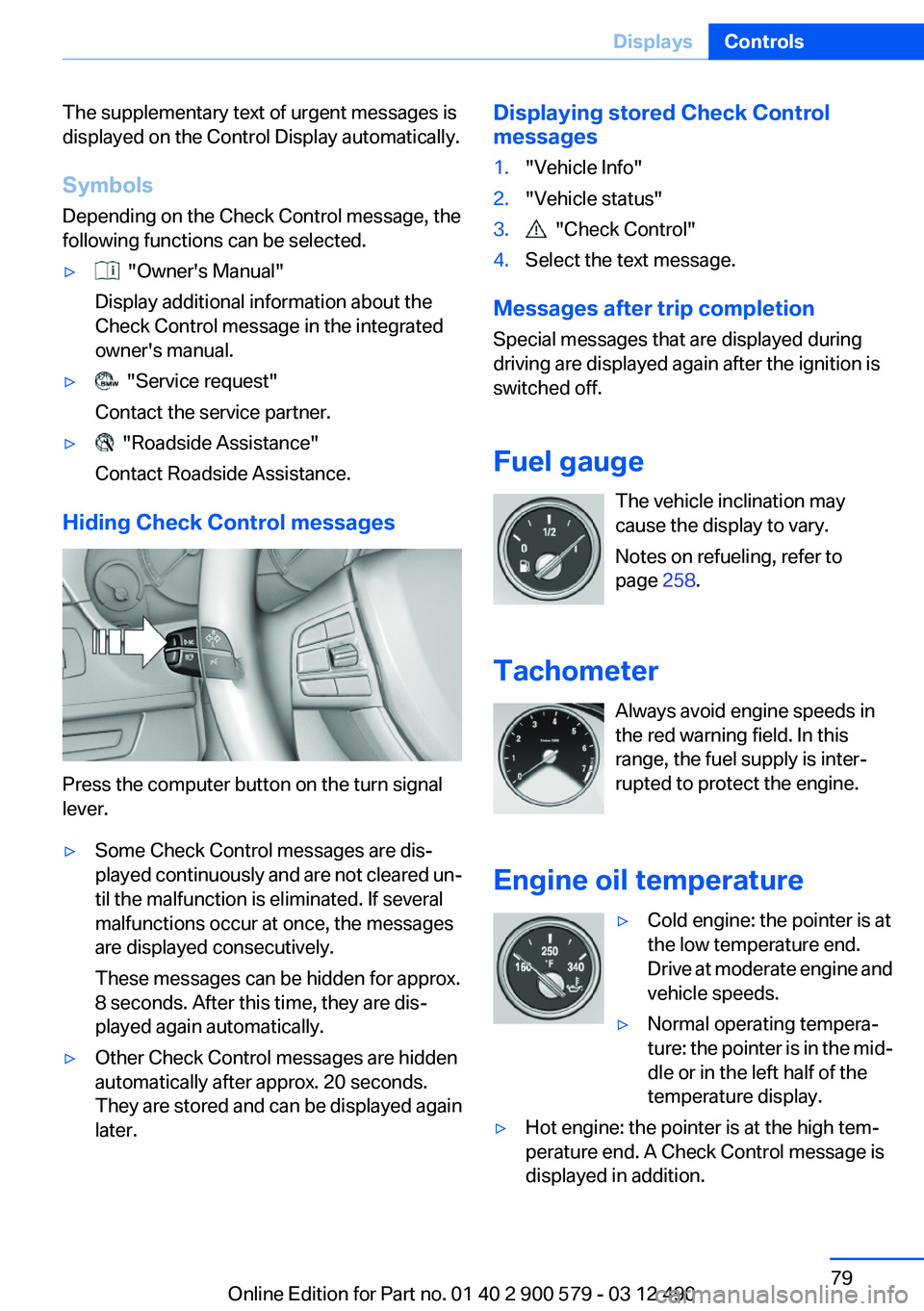
The supplementary text of urgent messages is
displayed on the Control Display automatically.
Symbols
Depending on the Check Control message, the
following functions can be selected.‚Ė∑ "Owner's Manual"
Display additional information about the
Check Control message in the integrated
owner's manual.‚Ė∑ "Service request"
Contact the service partner.‚Ė∑ "Roadside Assistance"
Contact Roadside Assistance.
Hiding Check Control messages
Press the computer button on the turn signal
lever.
‚Ė∑Some Check Control messages are dis‚Äź
played continuously and are not cleared un‚Äź
til the malfunction is eliminated. If several
malfunctions occur at once, the messages
are displayed consecutively.
These messages can be hidden for approx.
8 seconds. After this time, they are dis‚Äź
played again automatically.‚Ė∑Other Check Control messages are hidden
automatically after approx. 20 seconds.
They are stored and can be displayed again
later.Displaying stored Check Control
messages1."Vehicle Info"2."Vehicle status"3. "Check Control"4.Select the text message.
Messages after trip completion
Special messages that are displayed during
driving are displayed again after the ignition is
switched off.
Fuel gauge The vehicle inclination may
cause the display to vary.
Notes on refueling, refer to
page 258.
Tachometer Always avoid engine speeds in
the red warning field. In this
range, the fuel supply is inter‚Äź
rupted to protect the engine.
Engine oil temperature
‚Ė∑Cold engine: the pointer is at
the low temperature end.
Drive at moderate engine and
vehicle speeds.‚Ė∑Normal operating tempera‚Äź
ture: the pointer is in the mid‚Äź
dle or in the left half of the
temperature display.‚Ė∑Hot engine: the pointer is at the high tem‚Äź
perature end. A Check Control message is
displayed in addition.Seite 79DisplaysControls79
Online Edition for Part no. 01 40 2 900 579 - 03 12 490
Page 84 of 319
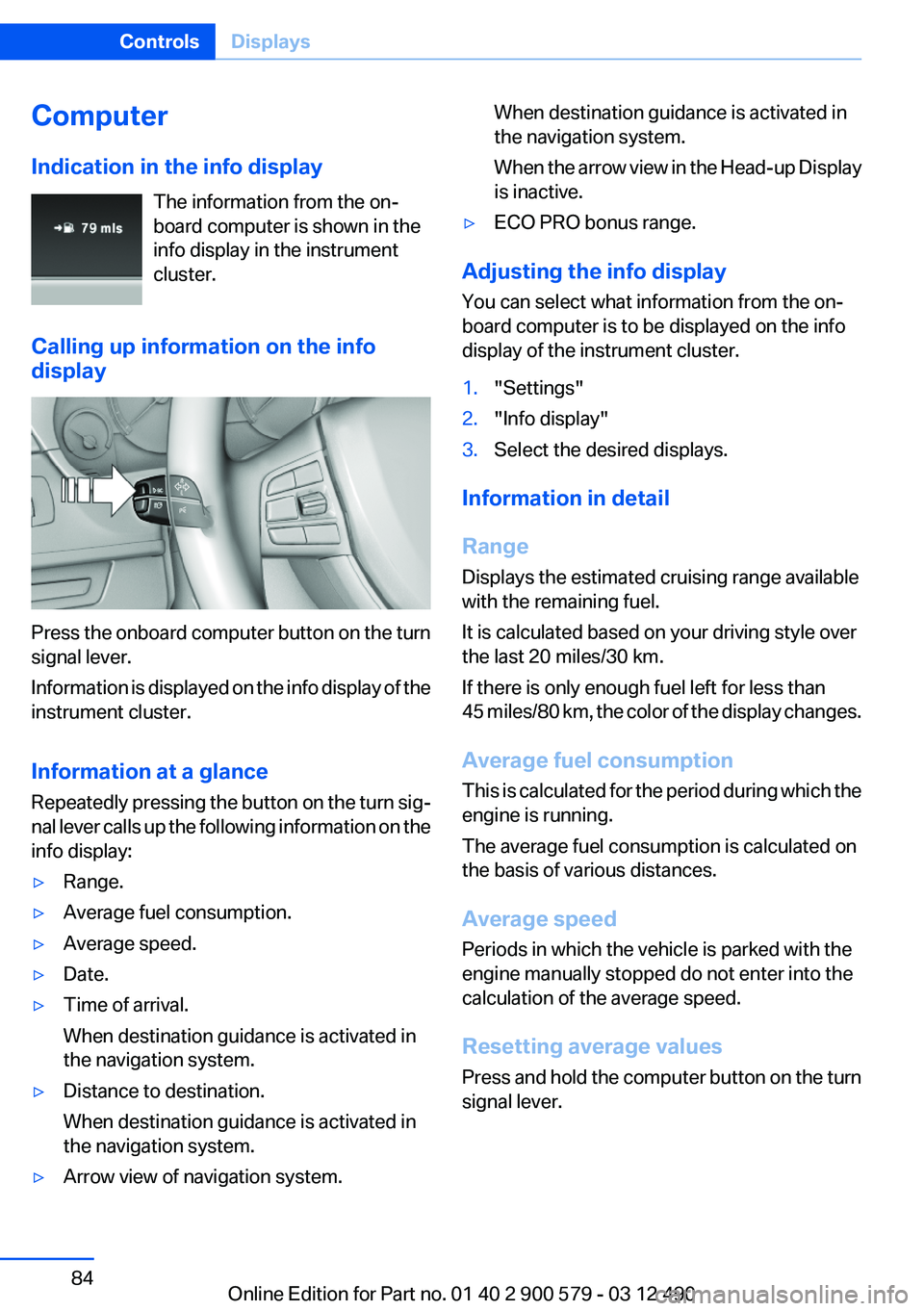
Computer
Indication in the info display The information from the on‚Äź
board computer is shown in the
info display in the instrument
cluster.
Calling up information on the info
display
Press the onboard computer button on the turn
signal lever.
Information is displayed on the info display of the
instrument cluster.
Information at a glance
Repeatedly pressing the button on the turn sig‚Äź
nal lever calls up the following information on the
info display:
‚Ė∑Range.‚Ė∑Average fuel consumption.‚Ė∑Average speed.‚Ė∑Date.‚Ė∑Time of arrival.
When destination guidance is activated in
the navigation system.‚Ė∑Distance to destination.
When destination guidance is activated in
the navigation system.‚Ė∑Arrow view of navigation system.When destination guidance is activated in
the navigation system.
When the arrow view in the Head-up Display
is inactive.‚Ė∑ECO PRO bonus range.
Adjusting the info display
You can select what information from the on‚Äź
board computer is to be displayed on the info
display of the instrument cluster.
1."Settings"2."Info display"3.Select the desired displays.
Information in detail
Range
Displays the estimated cruising range available
with the remaining fuel.
It is calculated based on your driving style over
the last 20 miles/30 km.
If there is only enough fuel left for less than
45 miles/80 km, the color of the display changes.
Average fuel consumption
This is calculated for the period during which the
engine is running.
The average fuel consumption is calculated on
the basis of various distances.
Average speed
Periods in which the vehicle is parked with the
engine manually stopped do not enter into the
calculation of the average speed.
Resetting average values
Press and hold the computer button on the turn
signal lever.
Seite 84ControlsDisplays84
Online Edition for Part no. 01 40 2 900 579 - 03 12 490
Page 91 of 319
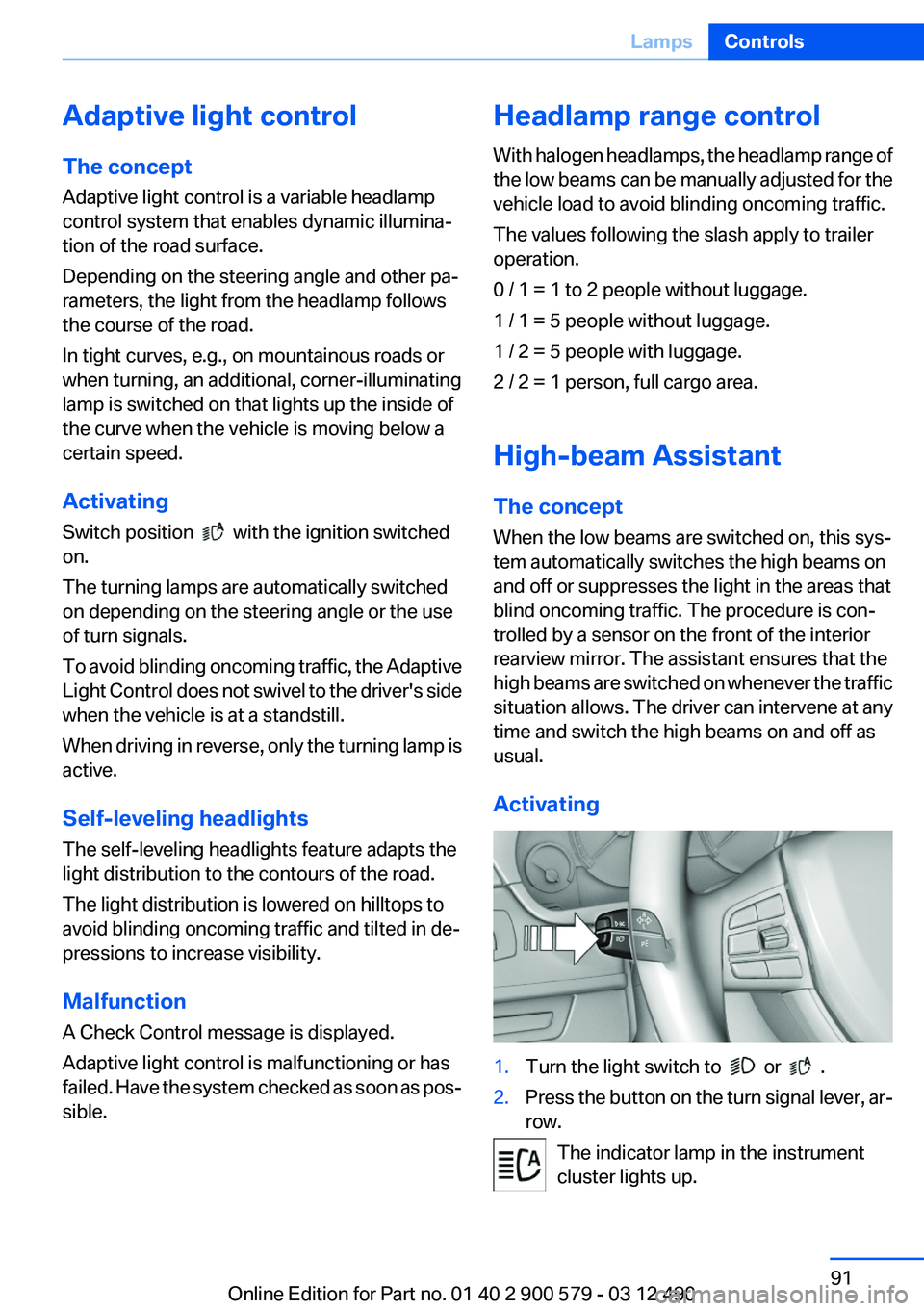
Adaptive light control
The concept
Adaptive light control is a variable headlamp
control system that enables dynamic illumina‚Äź
tion of the road surface.
Depending on the steering angle and other pa‚Äź
rameters, the light from the headlamp follows
the course of the road.
In tight curves, e.g., on mountainous roads or
when turning, an additional, corner-illuminating
lamp is switched on that lights up the inside of
the curve when the vehicle is moving below a
certain speed.
Activating
Switch position
with the ignition switched
on.
The turning lamps are automatically switched
on depending on the steering angle or the use
of turn signals.
To avoid blinding oncoming traffic, the Adaptive
Light Control does not swivel to the driver's side
when the vehicle is at a standstill.
When driving in reverse, only the turning lamp is
active.
Self-leveling headlights
The self-leveling headlights feature adapts the
light distribution to the contours of the road.
The light distribution is lowered on hilltops to
avoid blinding oncoming traffic and tilted in de‚Äź
pressions to increase visibility.
Malfunction
A Check Control message is displayed.
Adaptive light control is malfunctioning or has
failed. Have the system checked as soon as pos‚Äź
sible.
Headlamp range control
With halogen headlamps, the headlamp range of
the low beams can be manually adjusted for the
vehicle load to avoid blinding oncoming traffic.
The values following the slash apply to trailer
operation.
0 / 1 = 1 to 2 people without luggage.
1 / 1 = 5 people without luggage.
1 / 2 = 5 people with luggage.
2 / 2 = 1 person, full cargo area.
High-beam Assistant
The concept
When the low beams are switched on, this sys‚Äź
tem automatically switches the high beams on
and off or suppresses the light in the areas that
blind oncoming traffic. The procedure is con‚Äź
trolled by a sensor on the front of the interior
rearview mirror. The assistant ensures that the
high beams are switched on whenever the traffic
situation allows. The driver can intervene at any
time and switch the high beams on and off as
usual.
Activating1.Turn the light switch to or .2.Press the button on the turn signal lever, ar‚Äź
row.
The indicator lamp in the instrument
cluster lights up.
Seite 91LampsControls91
Online Edition for Part no. 01 40 2 900 579 - 03 12 490
Page 92 of 319
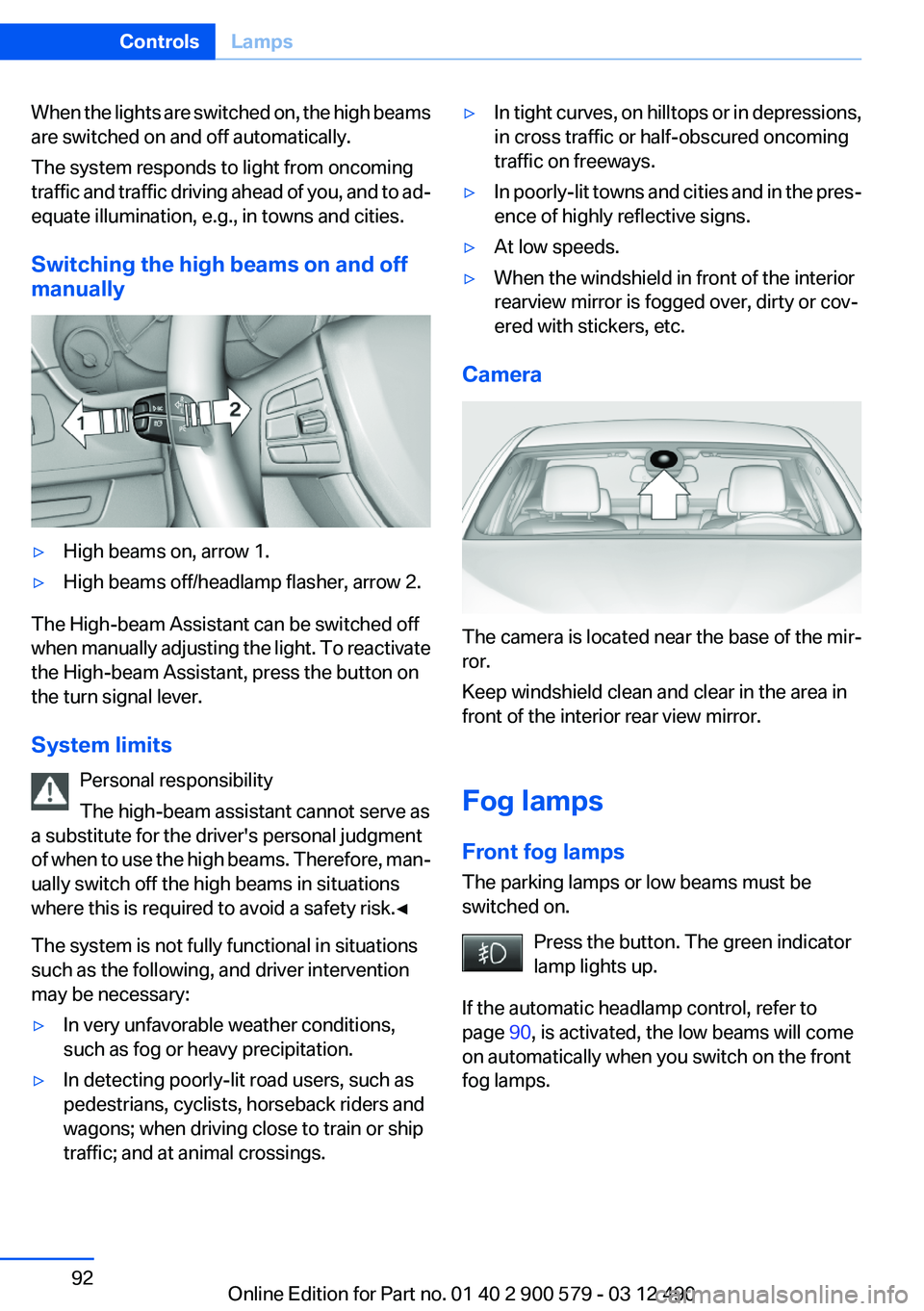
When the lights are switched on, the high beams
are switched on and off automatically.
The system responds to light from oncoming
traffic and traffic driving ahead of you, and to ad‚Äź
equate illumination, e.g., in towns and cities.
Switching the high beams on and off
manually‚Ė∑High beams on, arrow 1.‚Ė∑High beams off/headlamp flasher, arrow 2.
The High-beam Assistant can be switched off
when manually adjusting the light. To reactivate
the High-beam Assistant, press the button on
the turn signal lever.
System limits Personal responsibility
The high-beam assistant cannot serve as
a substitute for the driver's personal judgment
of when to use the high beams. Therefore, man‚Äź
ually switch off the high beams in situations
where this is required to avoid a safety risk.‚óÄ
The system is not fully functional in situations
such as the following, and driver intervention
may be necessary:
‚Ė∑In very unfavorable weather conditions,
such as fog or heavy precipitation.‚Ė∑In detecting poorly-lit road users, such as
pedestrians, cyclists, horseback riders and
wagons; when driving close to train or ship
traffic; and at animal crossings.‚Ė∑In tight curves, on hilltops or in depressions,
in cross traffic or half-obscured oncoming
traffic on freeways.‚Ė∑In poorly-lit towns and cities and in the pres‚Äź
ence of highly reflective signs.‚Ė∑At low speeds.‚Ė∑When the windshield in front of the interior
rearview mirror is fogged over, dirty or cov‚Äź
ered with stickers, etc.
Camera
The camera is located near the base of the mir‚Äź
ror.
Keep windshield clean and clear in the area in
front of the interior rear view mirror.
Fog lamps
Front fog lamps
The parking lamps or low beams must be
switched on.
Press the button. The green indicator
lamp lights up.
If the automatic headlamp control, refer to
page 90, is activated, the low beams will come
on automatically when you switch on the front
fog lamps.
Seite 92ControlsLamps92
Online Edition for Part no. 01 40 2 900 579 - 03 12 490
Page 102 of 319

Do this by checking the air pressure in all
four tires.
If the tire inflation pressure in all four tires is
correct, the Flat Tire Monitor may not have
been initialized. In this case, initialize the
system.
If an identification is not possible, please
contact the service center.2.Rectify the flat tire.
Run-flat tires
Maximum speed
You can continue driving with a damaged tire at
speeds up to 50 mph/80 km/h.
Continued driving with a flat tire
If continuing to drive with a damaged tire:
1.Avoid sudden braking and steering maneu‚Äź
vers.2.Do not exceed a speed of 50 mph/80 km/h.3.Check the air pressure in all four tires at the
next opportunity.
If the tire inflation pressure in all four tires is
correct, the Flat Tire Monitor may not have
been initialized. In this case, initialize the
system.
Possible driving distance with complete loss of
tire inflation pressure:
The possible driving distance after a loss of tire
inflation pressure depends on the cargo load
and the driving style and conditions.
For a vehicle containing an average load, the
possible driving distance is approx.
50 miles/80 km.
When the vehicle is driven with a damaged tire,
its handling characteristics change, e.g., re‚Äź
duced lane stability during braking, a longer
braking distance, and altered self-steering
properties. Adjust your driving style accord‚Äź
ingly. Avoid abrupt steering maneuvers or driv‚Äź
ing over obstacles, e.g., curbs, potholes, etc.
Because the possible driving distance depends
on how the vehicle is used during the trip, the
actual distance may be smaller or greater de‚Äź
pending on the driving speed, road conditions,
external temperature, cargo load, etc.
Continued driving with a flat tire
Drive moderately and do not exceed a
speed of 50 mph/80 km/h.
A loss of tire inflation pressure results in a
change in the handling characteristics, e.g., re‚Äź
duced lane stability during braking, a longer
braking distance and altered self-steering prop‚Äź
erties.‚óÄ
Final tire failure
Vibrations or loud noises while driving can
indicate the final failure of the tire. Reduce speed
and stop; otherwise, pieces of the tire could
come loose and cause an accident. Do not con‚Äź
tinue driving, and contact your service center. ‚óÄ
Lane departure warning
The concept
Starting at a specific speed, this system alerts
you when the vehicle on streets with lane mark‚Äź
ings is about to leave the lane. Depending on the
country-specific version of the vehicle, the
speed is between 35 mph/55 km/h and
45 mph/70 km/h. When switching on the system
below this speed, a message appears in the in‚Äź
strument cluster.
The steering wheel begins vibrating gently in the
event of warnings. The time of the warning may
vary depending on the current driving situation.
The system does not provide a warning if the
turn signal is set before leaving the lane.Seite 102ControlsSafety102
Online Edition for Part no. 01 40 2 900 579 - 03 12 490